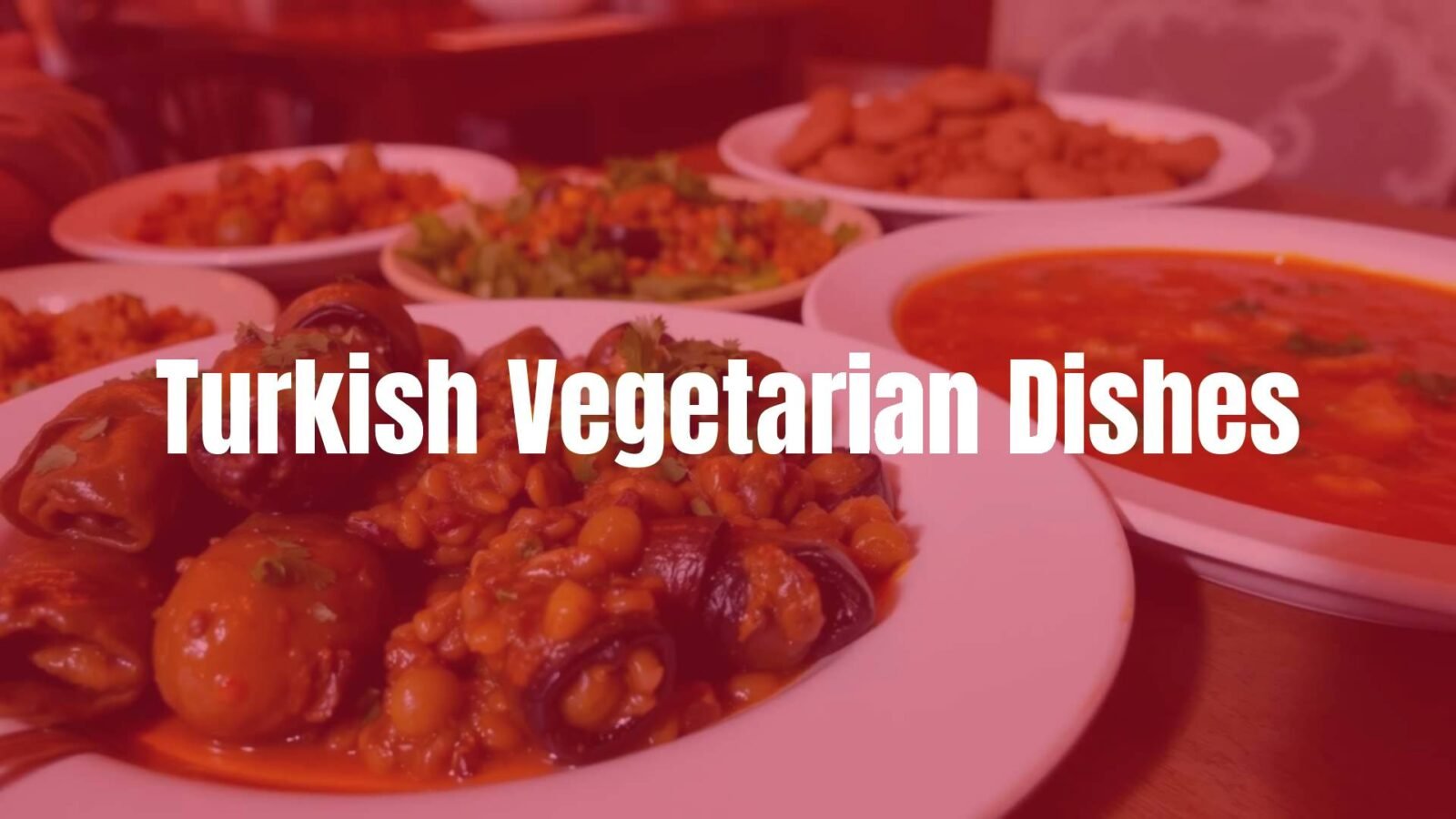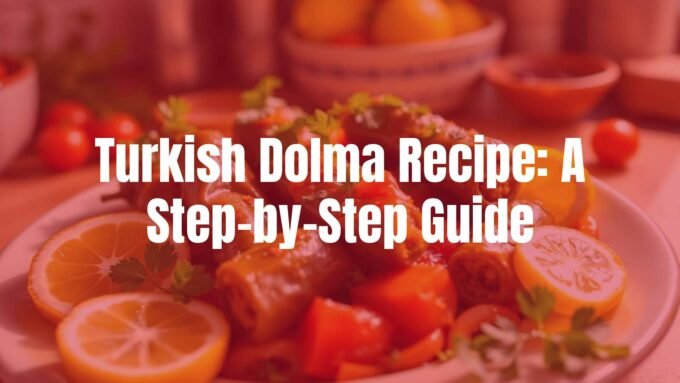Are Turkish vegetarian dishes worth trying? Yes! Turkish food is not just kebabs and meat. Meat-free dishes here use fresh produce, fragrant herbs, and filling legumes. Many travelers expect it to be hard to find vegetarian food, but it’s actually simple and fun. You’ll see plenty of tasty, healthy options across the country, even in small towns. This shows how strong Turkey’s cooking traditions are.
Turkish food can take simple ingredients and turn them into colorful, flavorful dishes. For vegetarians, many plates are main dishes, not just sides. The focus on seasonal, local ingredients makes every bite fresh and genuine. Whether you’re vegetarian, curious about new foods, or adding more plant-based meals to your week, Turkish vegetarian dishes offer a delicious, satisfying path.

What Are Turkish Vegetarian Dishes?
Turkish vegetarian dishes highlight what plants can do. They are fresh, full of flavor, and often have a warm, homey taste. These recipes are rooted in culture and tradition, shaped by centuries of cooking that favor seasonal, wholesome food. From light mezes to hearty stews, the range is wide and suits many tastes.
The strength of Turkish vegetarian cooking is how it builds rich, satisfying meals without meat. This shows the power of vegetables, legumes, and grains when treated with care and seasoned well. This approach makes the food tasty and naturally healthy, fitting today’s eating habits.
Key Ingredients in Turkish Vegetarian Cooking
The pantry is rich and varied. Legumes are a big part of it: lentils (mercimek), chickpeas (nohut), and different beans build many filling dishes. They add protein and a pleasing texture.
Vegetables are central. Eggplant (patlıcan), tomatoes (domates), peppers (biber), zucchini (kabak), onions (soğan), and garlic (sarımsak) appear often, forming the base of stews, mezes, and salads. Fresh herbs like parsley, mint, and dill are key, brightening flavors. Grains, especially bulgur, are common in salads like kısır and in pilafs. Dairy such as yogurt (yoğurt) and white cheese (beyaz peynir) also show up often, adding tang or a salty note.

Traditional Cooking Techniques Used in Turkish Vegetarian Cuisine
Many classic methods bring out the best in these ingredients. Slow simmering is common for olive oil dishes, letting flavors blend and vegetables soften. The Ottoman “bastı” method layers and gently presses sautéed ingredients before baking, as in Zeytinli Patates Bastısı (Baked Potatoes with Onions, Tomatoes, and Olives).
Grilling and shallow frying are popular for mezes and fritters like kabak mücver (zucchini fritters). Large, shallow pans help cook evenly and caramelize vegetables. Kneading is a key step for çiğ köfte and mercimek köftesi, where bulgur and lentils are worked with spices to get a special texture and taste. These time-tested methods play a big part in the distinct flavor and feel of Turkish vegetarian dishes.
Are Turkish Vegetarian Dishes Vegan-Friendly?
Many Turkish vegetarian dishes are naturally vegan or can be made vegan with small changes, so plant-based eaters will do well here. The heavy use of fruits, vegetables, legumes, and grains gives a strong base. Olive oil dishes (zeytinyağlılar) are often vegan, and many salads and bulgur dishes are too.
Still, watch out for dairy. Yogurt and cheese are common, like in cacık (cucumber and yogurt dip) or some gozleme (stuffed flatbread). When ordering, ask about ingredients. Many places can offer vegan options. Popular vegan choices include çiğ köfte (now usually vegan), sarma (stuffed grape leaves), and mercimek köftesi (lentil patties). More restaurants now list vegan versions of classics, such as using tofu instead of eggs in menemen or plant-based cheeses in pastries.
What Makes Turkish Vegetarian Cuisine Unique?
This cuisine stands out for a mix of reasons tied to history, geography, and tradition. It’s about more than skipping meat; it’s a way of cooking that celebrates the natural taste and texture of plants.
The food builds bold, satisfying flavors from simple, fresh ingredients. You’ll find dishes that are both comforting and exciting, from tangy and spicy to sweet and savory. It invites you to try new things and rewards you with great taste.
Regional Flavors and Specialties
Turkey’s varied land shapes many regional specialties. From the Mediterranean coast to the Black Sea and eastern Anatolia, each area has its own style. In Gaziantep, famous for pistachios and baklava, you’ll also find Antep Ezmesi (a spicy red pepper and walnut dip) and herb-packed Öcce fritters. The Aegean region shines with fresh herbs and vegetables, often cooked in olive oil for light, bright dishes.
Travelers who visit different regions will spot local twists on shared favorites and discover new plates. Falafel, while Middle Eastern, is common and loved, especially near Syria in places like Gaziantep and Mardin. Muhlama, a rich, gooey cheese dish, is found mainly in the north. This regional variety makes Turkish vegetarian food especially appealing.
Seasonality and Fresh Produce
At the core of Turkish vegetarian cooking is a deep respect for seasonal, local produce. Markets overflow with colorful fruits, vegetables, and herbs that are used at their best.
Seasonal cooking means menus change through the year. Spring brings artichokes and fresh greens; summer is full of tomatoes, eggplant, and zucchini; autumn brings root vegetables and legumes. This natural rhythm leads to delicious food and a healthy, sustainable way to eat, letting ingredients shine on their own.
Role of Olive Oil in Turkish Vegetarian Dishes
Olive oil is a basic ingredient, especially in “zeytinyağlılar” (dishes cooked in olive oil). These plates are often served cold or at room temperature, perfect for meze or light summer meals. Good olive oil adds richness, a silky feel, and a gentle fruity note that lifts the vegetables.
From green beans (zeytinyağlı taze fasulye) to stuffed artichokes (zeytinyağlı enginar) and Imam Bayıldı (stuffed eggplant), olive oil helps keep the dish and makes flavors stronger. It’s often drizzled on top before serving for extra taste and sheen. This shows the Mediterranean roots of Turkish food and its focus on wholesome, flavorful cooking.
Popular Types of Turkish Vegetarian Dishes
Turkish vegetarian food is very diverse, with options for every taste and time of day. You’ll find small plates for sharing and hearty mains that fill you up. Exploring these dishes is a joy for anyone eating plant-based.
The groups below show how vegetables, legumes, and grains are turned into great dishes. Each type reflects a part of Turkish food culture, from the social feel of meze to the comfort of home-style stews.
Vegetable Meze Plates
Meze are small starters that play a big role in Turkish meals, and many are vegetable-based. A mixed meze plate is perfect for vegetarians, offering many flavors and textures. You might see stuffed grape leaves (sarma), vegetable stews, creamy yogurt dips, and crispy fritters. Meze is all about sharing and tasting different dishes full of herbs, spices, and olive oil.

Popular choices include Ezme (spicy tomato and pepper dip), Haydari (thick yogurt dip with garlic and mint), and Patlıcan Salatası (eggplant salad). These plates are delicious and also show the fresh colors and ingredients that define Turkish food, making them a great first step into its vegetarian side.
Olive Oil Dishes (Zeytinyağlılar)
These olive oil dishes are a hallmark of vegetarian cooking in the Aegean and Mediterranean areas. They are cooked until tender, then cooled and served at room temperature, so the vegetables and olive oil can shine. They tend to be light, refreshing, and nutritious.
Examples include Zeytinyağlı Taze Fasulye (green beans in olive oil), Zeytinyağlı Enginar (artichokes in olive oil), and Barbunya Pilaki (borlotti beans in tomato and olive oil). Slow cooking in olive oil makes the vegetables very tender and brings out a gentle, savory sweetness. Serve them as part of a meze spread or as a light main.
Hearty Vegetarian Stews and Casseroles
Beyond meze and olive oil dishes, there are many filling stews and casseroles. These often start with tomatoes, onions, and peppers, then add vegetables and legumes for a full meal.
Şakşuka, a classic mix of eggplant, tomatoes, and spices, can be a meze or a main. Karnabahar Yemeği (cauliflower stew) and Ekşili Patlıcan (sour eggplant stew) also show how everyday vegetables can make flavorful, satisfying meals. These dishes are simmered until tender and well-blended, great for cooler days or whenever you want a more filling plate.
Pastries, Breads, and Savory Pies
Turkish bakeries and street stalls are great for vegetarians, with many pastries, breads, and pies. Fillings often include vegetables, cheese, and herbs-ideal for breakfast, a snack, or a light meal.
Gözleme, a thin flatbread, is worth trying. It’s filled with spinach, potato, or cheese and cooked on a domed griddle. Pide, sometimes called Turkish pizza, comes with toppings like vegetables, cheese, and egg. Börek has flaky layers and similar fillings. And Simit, the sesame-crusted bread ring, is a classic grab-and-go bite. These baked goods show off the range of Turkish dough and fillings.
Legume-Based Dishes
Legumes are a key part of Turkish vegetarian food, adding protein, fiber, and heartiness. Lentils, chickpeas, and beans appear in soups, salads, and mains.
Mercimek Köftesi (lentil patties) blends red lentils and bulgur with spices and herbs. Kuru Fasulye (white bean stew) has meatless versions that are very comforting, much like a rich bean curry with rice. Chickpea dishes, from falafel to salads, are common. These meals are nutritious and show smart ways to use plant proteins.
Salads and Cold Starters
Turkish salads and cold starters are bright and fresh. They often use finely chopped vegetables, lemon juice, and olive oil-great on their own or beside other dishes.
Çoban Salatası (Shepherd’s Salad) mixes tomatoes, cucumbers, and onions. Gavurdağı Salatası adds walnuts and pomegranate molasses for a sweet-sour kick. Patates Salatası (potato salad) and Yeşil Mercimek Salatası (green lentil salad) are more filling. These plates are colorful, healthy, and full of flavor.
Famous Turkish Vegetarian Dishes To Try
Exploring Turkey as a vegetarian is a joy, with many flavor-packed finds. Beyond the general groups, some dishes are true classics and worth seeking out. They show how Turkish cooking can turn simple, fresh ingredients into meals you remember.
From breakfast to meze to mains, the list below gathers some of the best vegetarian plates. Each one reflects regional habits, seasonal produce, and a careful balance of flavor and texture.
Menemen (Turkish Egg and Tomato Scramble)
Menemen is a breakfast favorite, but people eat it any time. Onions, green peppers, and tomatoes are cooked until soft, then eggs are scrambled in, making a rich, tasty mix. Vegan versions skip the eggs or use tofu while keeping the same vegetable-spice base.
It’s served hot with plenty of fresh bread. Simple but very satisfying, it’s a great start to the day or a cozy meal later on.
Imam Bayıldı (Stuffed Eggplant in Olive Oil)
Imam Bayıldı, “the imam fainted,” is a beloved vegan-friendly dish. Whole eggplants are slit and stuffed with sautéed onions, garlic, tomatoes, and spices, then slowly cooked in olive oil. The eggplant turns soft and silky, with deep, layered flavors.

As a classic olive oil dish, it’s usually served cold or at room temperature. Imam Bayıldı shows how humble vegetables can become a dish fit for any table, as a meze or a light main.
Çiğ Köfte (Spicy Bulgur Patties)
Çiğ Köfte is hugely popular. While it once used raw meat, today it’s almost always vegan, made with fine bulgur kneaded with tomato and pepper pastes, spices, and sometimes pomegranate syrup until smooth and firm.
Served in lettuce leaves with lemon, mint, and parsley, it’s spicy, tangy, and very moreish-a great snack or starter that highlights bulgur’s versatility.
Mercimek Köftesi (Lentil Meatballs)
Mercimek Köftesi are vegan-friendly patties made from red lentils and fine bulgur, mixed with onions, tomato paste, and spices, then shaped by hand.
They’re flavorful and satisfying, with earthy lentils, chewy bulgur, and aromatic spices. Served cold with parsley and lemon, they’re a wholesome, tasty plant-based option.
Kısır (Bulgur Salad)
Kısır is a bright bulgur salad with bold, zesty flavors. Fine bulgur is soaked (not boiled), then mixed with tomatoes, cucumbers, spring onions, parsley, and mint. Olive oil, lemon juice, and pomegranate molasses (nar ekşisi) give it a tangy, slightly sweet taste.
Kısır is common on meze platters and works as a light lunch or side. Its color, crunch, and lively dressing make it hard to resist.
Gözleme (Stuffed Flatbread)
Gözleme is a thin, hand-rolled flatbread filled with ingredients like spinach, white cheese, and spiced potato, then cooked on a hot sac griddle.
The golden, crisp outside contrasts with the warm, soft filling. It’s popular as street food and perfect for breakfast, lunch, or a snack, often with ayran (buttermilk) or tea.
Zeytinyağlı Taze Fasulye (Green Beans in Olive Oil)
This classic olive oil dish celebrates green beans. They simmer slowly with tomatoes, onions, and plenty of olive oil until very tender and sweet-savory.
Served cold or at room temperature, it’s a fresh, healthy meze or side that shows how a few good ingredients and careful cooking can make a memorable plate.
Kabak Mücver (Zucchini Fritters)
Kabak Mücver are crispy-tender zucchini fritters made with grated zucchini, flour, eggs (or chickpea flour for vegan versions), and herbs like dill and mint, then shallow-fried until golden.
Often part of a meze spread, they offer great texture and bright, herby flavor-especially popular in summer when zucchini is plentiful.
Şakşuka (Eggplant and Tomato Stew)
Turkish Şakşuka is a rich mix of sautéed eggplant, green peppers, and tomatoes with garlic and spices. The vegetables turn soft and soak up the sauce.
Enjoy it warm or cold, as a meze or main with bread. Şakşuka shows how well-cooked eggplant can make a deeply satisfying vegetarian dish.
Pide (Turkish Flatbread with Vegetable Toppings)
Pide is a boat-shaped flatbread baked until chewy and golden. Vegetarian versions come with cheese, spinach, mushrooms, peppers, tomatoes, or a mix of these. Sometimes an egg is cracked on top and baked until just set.
With a thick crust and tasty toppings, pide is filling and comforting, found everywhere from city restaurants to small bakeries.
Barbunya Pilaki (Borlotti Beans in Tomato Sauce)
Barbunya Pilaki is a classic olive oil dish featuring borlotti beans cooked slowly in a tomato, onion, garlic, and carrot sauce with lots of olive oil. The beans become tender and creamy.
Served cold or at room temperature, it’s a refreshing, nutritious meze for warm days. Bold flavors and a pleasing texture make it a favorite.
Simit (Sesame-Crusted Bread Rings)
Simit is a famous sesame-crusted bread ring-chewy inside, crisp outside. It’s naturally vegan and easy to find.
People enjoy it for breakfast or as a snack, often with tea, cheese, and olives. Street carts, bakeries, and even ferries sell it, making it a quick, authentic bite.
How To Order and Enjoy Vegetarian Food in Turkey
Figuring out a new cuisine as a vegetarian can seem tricky, but in Turkey it’s usually simple and enjoyable. Learn a few phrases, get used to typical menus, and eat the local way. With a bit of prep, you’ll enjoy many great vegetarian dishes.
Don’t hesitate to ask questions or make requests. People are welcoming and want guests to enjoy their meals. Be curious, and you’ll see that vegetarian eating in Turkey is easy and rewarding.
Common Turkish Words for Vegetarian Dishes
Learning a few key phrases can really help your vegetarian dining. Try these:
- Vejetaryen: Vegetarian (pronounced: veh-jeh-TAR-yen)
- Vegan: Vegan (pronounced: VAY-gahn)
- Et yok: No meat (pronounced: et YOHK)
- Tavuk yok: No chicken (pronounced: tah-VOOK YOHK)
- Balık yok: No fish (pronounced: bah-LUK YOHK)
- Süt ürünleri yok: No dairy products (pronounced: soot y-roon-LER-ee YOHK)
- Peynir yok: No cheese (pronounced: pey-NEER YOHK)
- Yumurta yok: No egg (pronounced: yoo-moor-TAH YOHK)
- Zeytinyağlı: Cooked in olive oil (often vegetarian, many are vegan) (pronounced: zey-teen-YAH-luh)
- Sebze: Vegetable (pronounced: seb-ZEH)
- Mercimek: Lentil (pronounced: mer-jee-MEK)
- Nohut: Chickpea (pronounced: no-HOOT)
Use these along with pointing or asking for suggestions to order with confidence.
Tips for Eating Out as a Vegetarian in Turkey
Eating out is generally easy and satisfying. These tips can help:
- Enjoy Meze: Many meze plates are vegetarian or vegan. Order several small dishes to make a full meal.
- Seek “Zeytinyağlı” Dishes: Olive oil vegetable dishes are almost always vegetarian and often vegan, and they’re usually served cold.
- Ask and Clarify: Some soups or stews might use meat broth. Ask “Et suyu var mı?” (Is there meat broth?) or confirm “Vejetaryen mi?” (Is it vegetarian?).
- Try Lokantas (Esnaf Lokantası): These serve home-style food in trays. You can point to vegetable and legume dishes, which are often plentiful.
- Street Food: Don’t skip it. Simit, gozleme (with vegetable or cheese), and çiğ köfte are great vegetarian picks.
- Breakfast Spreads: Turkish breakfast (serpme kahvaltı) is generous: cheeses, olives, tomatoes, cucumbers, jams, honey, and bread. Just skip any cured meats offered.
- Be Curious: Try spots outside tourist centers. Small local places often serve the most authentic vegetarian food.

Understanding Menus and Food Labels
Knowing menu sections makes ordering easier. In tourist areas, menus often have English, but these Turkish terms help:
- Mezeler: Appetizers; many are vegetarian (ezme, haydari, patlıcan salatası, kısır, mercimek köftesi, sarma).
- Zeytinyağlılar: Olive oil dishes; usually vegetable-based and often vegan.
- Çorbalar: Soups. Ask if they use water or vegetable stock, as some use chicken or meat stock.
- Salatalar: Salads. Generally safe; surprise meat additions are rare but you can check.
- Pide/Lahmacun: Lahmacun is meat-topped, but pide has many vegetarian options.
- Börek/Gözleme: Pastries with spinach, potato, or cheese-great vegetarian choices.
In supermarkets, ingredient lists are in Turkish, so knowing “et” (meat), “süt” (milk), and “yumurta” (egg) helps. In restaurants, just asking is usually enough. Turkey’s food scene makes it easy for vegetarians to eat well and with variety.
Frequently Asked Questions About Turkish Vegetarian Dishes
Is vegetarian food widely available in Turkey?
Many people think Turkey is all about meat, but vegetarian food is common and part of daily life. Home cooking and traditional spots serve many vegetables, legumes, and grains. You’ll find lots of options: mezes, olive oil dishes (zeytinyağlılar), and stews. Even small towns offer wholesome, tasty vegetarian meals. With so much fresh produce, Turkey is very friendly for vegetarians.
Are ingredients like cheese and yogurt common in Turkish vegetarian meals?
Yes. White cheese (beyaz peynir), like feta, is standard in breakfasts, salads, börek, and gözleme. Yogurt (yoğurt) is everywhere too-in dips like cacık, beside mains, and in soups and sauces. It adds creaminess and tang. For vegans, you can often ask for alternatives or skip dairy, and many dishes are already dairy-free.
What should vegans know about Turkish cuisine?
Vegans have many choices. Start with “zeytinyağlı” dishes (olive oil vegetables), which are usually vegan-like Imam Bayıldı, Barbunya Pilaki, and Zeytinyağlı Taze Fasulye. Legume dishes such as Mercimek Köftesi and Çiğ Köfte (now almost always vegan) are also great. Salads and bulgur dishes are typically vegan-just ask for no dairy dressing. When ordering, say “vegan,” “süt ürünleri yok” (no dairy), and “yumurta yok” (no egg). While some soups use meat broth, many lentil and vegetable soups can be made with water or vegetable stock.
Are Turkish desserts suitable for vegetarians?
Most are fine for vegetarians, since they don’t use meat. Many sweets are based on fruit, nuts, semolina, or filo, with syrup or honey. Examples include baklava, künefe (cheese pastry with syrup), sütlaç (rice pudding), lokma (fried dough in syrup), and fruit desserts like Kuru Kayısı Tatlısı (poached dried apricots with clotted cream). Vegans should check for milk, cream, or eggs in some recipes. Ask about ingredients if you avoid animal products. Overall, there’s plenty for a sweet tooth.
















Leave a comment